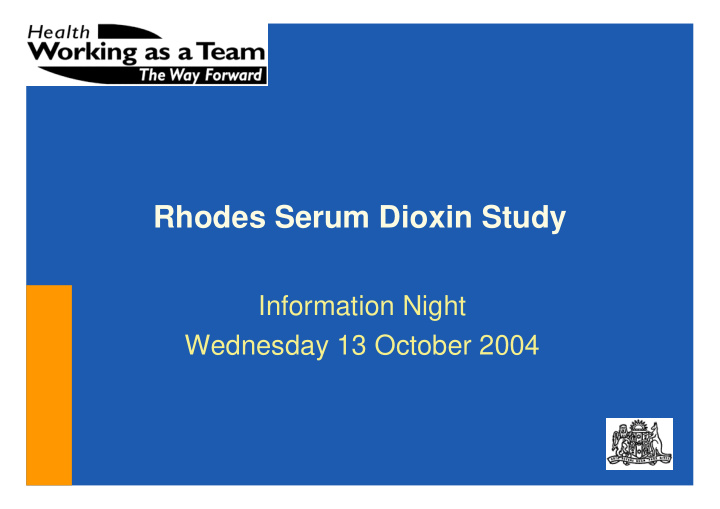



Rhodes Serum Dioxin Study Information Night Wednesday 13 October 2004
Rhodes Serum Dioxin Study 1. Background 2. Study logistics 3. Interpretation of study results
Background • Dioxins • organochlorine compounds • produced during incomplete combustion • natural processes eg bushfires • chemical processes eg paper bleaching • industrial processes eg pesticide manufacture
Why are dioxins a problem? • Persistent in the environment • Accumulate in fat up the food chain • Mass release in industrialised countries in 1930s-60s • Toxic
Dioxin toxicity • Promote cancer in animal studies • Associated with cancer (esp lung and blood) in people • occupationally exposed for more than 1 year • 20 or more years latency • Other effects in people occupationally exposed eg skin conditions
What levels are toxic? • International debate about possible effects of dioxins at lower levels • Little solid evidence to date of effects in humans at levels most people are exposed to • NHMRC established tolerable monthly intake for Australians in 2002
International Body Burdens • All populations have been exposed to dioxins • 95-99% of exposure is through diet • Fish and meat • Eggs and dairy products
International body burdens • Levels are falling internationally since decreased production 20-30 years ago • Older people have higher body burdens
Average concentration of TCDD in human blood from general populations Place and time of measurement 7 USA, 1987-1988 5.6 New Zealand, 1988 4.5 Russia (St Petersburg), 1988-1989 4.1 Finland, 1989-1990 3.6 Norway, 1993 3.1 Japan, 1991-1992 2.9 Germany, 1994 2.5 Sweden, 1990 2.1 USA, 1995-1997 1.52 Spain (Madrid), 1993 0 1 2 3 4 5 6 7 8 TCDD concentration (ng/kg fat)
• Dioxins in Australia • National Dioxin Assessment • Levels in Australian population lower than other industrialised countries • Website www.deh.gov.au/industry/chemicals/dio xins/index.html
Australian serum dioxin levels in National Dioxin Assessment (South East Urban, TEQ pg/g lipid) 30 25 20 15 Males Females 10 5 0 <16 yrs 16-30 31-45 46-60 >60 yrs yrs yrs yrs
Dioxin levels in perspective • Serum levels associated with cancer and other effects in occupational cohorts • Mean 1400-2200 pg/g • Serum levels of Australians • Mean 10.9 pg/g
Rhodes Serum Dioxin Study
Aim • To follow blood dioxin levels during remediation to: • Identify an increase requiring review of remediation control measures or • To reconfirm that remediation measures have been effective
Why? • Dioxins on sites to be remediated • Modelling » small levels of dioxin containing dust • Community concern • Monitoring on site • Extra level of monitoring of residents
How? • 50 mls of blood donated from eligible people • Now • at the peak of remediation • at the end of remediation • Blood from a control group • Short questionnaire
50mls is 5 X 10ml tubes No other tests needed
How? • Dioxin in serum ~ body burden • Measurement on pooled blood
• Who is eligible to participate? • 200 volunteers • Men 30 and over • Women 45 and over • People living on the peninsula who intend to stay living here for the next 5 years • Not previously worked with pesticides or at the Union Carbide site
Why these people? • Greatest impact, if any • Feasible • exclude children • Reduce variability • eg pregnancy and breastfeeding change body burdens
What does participation involve? • Registration • Completion of Consent Form and Questionnaire • Donation of a 50ml blood sample at Davies Campbell de Lambert Pathology, 2 Leeds St Rhodes
What do we need? • As many people as possible to donate blood (at least 40) • Precision depends on number of people who participate • Community input and agreement regarding timing of second and third collections
Interpretation of results
Possible results • Rhodes- Control: no change • Rhodes- Control: decreased • Rhodes- Control: increased • by how much? • is it significant?
Rhodes group Time 0 Control group Difference 8.5ng Rhodes group Time 1 NO YES Control group ACTION Rhodes group Time 2 Difference 8.5ng Control group NO YES
Interpretation • Level of detection based upon Tolerable Monthly Intake • Detection of a change does not mean increased risk of health effect • Detection of a change may mean remediation controls not strict enough
Summary • The Rhodes Serum Dioxin Study aims to detect if there has been an increase in the community ’ s exposure to dioxin whilst remediation is being conducted on the Rhodes peninsula
NSW Health Project Team • Dr Michael Staff • Dr Vicky Sheppeard • Dr Alison Rutherford • Dr Bradley Forssman • More information at www.health.nsw.gov.au/rhodes • Contact us on 9816 0234
Clinic times • Davies Campbell de Lambert Pathology, 2 Leeds St Rhodes • Thursday 14 October 5pm-830pm • Friday 15 October 10am-12pm and 3- 6pm • Saturday 16 October 9am-1230pm
Recommend
More recommend